ALAN
ZISMAN ON
TECHNOLOGY
So you think you want to buy an accordion
pt 2: Some quick checks
By Alan Zisman © 2020-03-01; updated 2020-04-10
So you want to get an accordion.
Hopefully you've already looked at Part 1 of this blog and have decided what sort of accordion you want, and now know a little bit about the differences between low-end, mid-range, and high-end accordions.
And you've checked your local online second hand listings site - perhaps Craigslist, perhaps Kijiji, or other.... or perhaps you're in a local pawn shop or music store that has some accordions. Or you're at a garage sale or an estate sale. Or anywhere where you can get your hands on an accordion - whether you've ever played accordion or not.
How can you tell if an accordion's worth buying? Or if you should just walk away?
I'm assuming you're wanting to know if an accordion's playable or if it needs expensive work to make it playable. If you just want something cool and vintage to put on display, that's entirely up to your tastes.
And only you can decide if this playable accordion is the right choice for the musical style(s) you want to play - though Part 1of this blog can help you see what sorts of accordions are commonly used in what sorts of musical styles. And only you can decide whether any given accordion is too heavy or large for you to work with comfortably. (Don't give up to soon - you can learn to work with an accordion that seems to heavy right now. Within limits).
So you've got an accordion in your hands right now. I'm going to assume you haven't played one before - if you have, you can roll your eyes but still do all these tests.
First things first:
-- the keys go on the right side. (You laugh - but I know two people who started out playing with the keys on the left, and not knowing that it felt awkward for a reason).
-- before you try to open or close the bellows: make sure you're holding down a key or button. You need air to get into the accordion when the bellows move - and that happens either when you hold down a key or button (in which case you'll hear a musical sound) or hold down the air release valve on the left hand side (in which case you'll hear a bit of a sucking sound).
-- in order to make any musical sounds, you need to have the bellows in motion, either in or out. If you have a diatonic accordion (see Part 1), which plays different notes depending on whether the bellows are moving in or out, you'll have short, jerky bellow motions in order to access the different notes. On piano-accordions or chromatic button accordions (rare in North America, but common in Europe), you want long, smooth bellow motions. Slowly count to 4 before changing bellows direction.
Things you can quickly check:
-- Visually inspect the accordion. Any obviously broken keys or buttons? Are the keys level? (This is a relatively easy fix, but it's a sign the accordion hasn't been well loved). A little bit of wear on the edge of the bellows - where they might have come in contact with a belt buckle, for instance, is not a deal-breaker, but something to be aware of. Straps in good shape? Short side straps to hold the bellows closed? Strap for the left hand to hold the accordion when you're playing? (There's a wheel on the left side to loosen or tighten this).
-- Holding the air release valve or a key or button, slowly open the bellows - pull them open for a slow count of 4, then change direction and slowly close them. There should be a bit of resistance from the bellows as you open or close them. That indicates good çompression. If they sort of flop open or closed with no effort at all, they're probably leaking. Leaky bellows can be repaired - depending on the source of the leaks - taped (use proper bellows tape - not masking tape!), or replace the metal corners or the gaskets where the bellows attach to the body of the accordion can be replaced (don't use silicone seal!). Or the bellows can be replaced (not cheap).
Reader Rich Edwards on the Facebook Accordion Repair group notes: "I have found that bellows leaks often happen at the corners where the diamond shaped leathers have perished".
Give a good sniff when you first take the accordion out of the case and again when you first open and close the bellows. Notice a musty, mildewy smell? This is accordion bad breath and it's not a good sign. It suggests the accordion has been stored in a damp place - perhaps a basement or garage. Not only is the smell unpleasant, but it's a sign the accordion's steel reeds may be getting rusty. If that's the case, it will be impossible to keep in tune and the reeds may snap if you play them loudly. Replacing the reeds is cost prohibitive. Walk away.
-- Moving the bellows slowly in and out, press each key on the keyboard (treble) side. Then press down each button on the bass side. Does each play a note (or chord for many of the buttons)? Do the keys or buttons come back up after they've been depressed or do some stick? Stuck bass buttons are not (generally) a big deal - but they can happen for a variety of reasons, and it's one more thing to have to deal with.
-- Take the time to test each key to see if the sound it makes when it's played (remember to keep the bellows moving!) sounds musical - more or less in tune. Test each key with the bellows moving out and moving in - there are separate reeds making the sound for each bellows direction. If those two notes sound (pretty much) the same, they're probably in tune. ('In tune' is a relative concept with accordion!). Accordions can be tuned, but it's complex - and something you want a technician to do.
You may feel comfortable buying a used accordion with one or two 'sour' notes or sticky keys - these can be avoided and eventually fixed.... but more than that and you have a major (and potentially expensive) project on your hands.
If your accordion has multiple tone switches on the treble (keyboard) side (see Part 1) test each key (bellows in, bellows out) with the low, middle, and high reeds (depending on how many reeds your accordion has (again, there's a detailed discussion in Part 1). That's because there are separate pairs of reeds in each reed block for each key on the keyboard. You need to know whether the accordion is pretty much in tune - or if there are major tuning issues.
-- Repeat with the left hand buttons. Luckily, you don't have to test every single button (full-sized models have 120 buttons). The buttons are in rows running from the top of the accordion (the side nearest your chin) to the bottom (the side nearest your knees) - the first two of these rows play single notes, the others play chords. You can just test all the buttons on the first or second of these rows. Again, for each button, with bellows moving out and movng in. If your accordion has multiple tone switches on the bass (button) side repeat (with bellows in and out) for each different switch to check all the bass reeds.
Your checklist so far:
____ Visual inspection. Everything look good?
____ Bellows movement: Good compression? No bad smells?
____ Key and button movement: Everything makes a sound? Nothing sticking?
____ Keys all sound in tune (more or less)?
____ Buttons all sound in tune (more or less)?
If the used accordion has passed all these tests, it may be worth buying. To be absolutely sure, you may want to open it up and take a look around. This is easier to do than you probably think - but you'll need a pair of pliers, a screwdriver (usually a flat-head, sometimes a Phillips) and a bit more time (though probably only 5-10 minutes). If it's not your accordion, be sure to ask permission first!
Opening up the accordion:
While there are literally thousands of pieces in an accordion, each accordion is made of three major sections - one houses all the keyboard (treble) side parts, one houses all the bass (button) side parts, and the bellows fits in between these two. The bellows are typically held onto each of the two other sections by six pins.
Put the accordion down on a table (I put a towel down so the accordion won't scratch the table). Open the straps on the sides that hold the bellows closed. With your pliers, carefully pull up on one of the pins holding the treble (keyboard side) onto the bellows, to pull it straight out. Put it aside. Repeat for the other two pins holding the treble side onto the bellows. Pay attention to which pin came from which hole - they'll be easier to put back in if they go back in the same holes each came from.
Turn the accordion over and repeat with the three pins holding the treble side into the bellows - you can leave the bass section attached to the bellows.
When all six pins are removed, you should be able to carefully remove the whole treble section from the bellows. Here's a Youtube clip of this operation:
See - that wasn't so hard!
Take a look inside the treble section. You'll see several wooden reed blocks - 2, 3, or 4 - usually in parallel rows. (The accordion in the video is an expensive model, with two of the reed blocks in a 'tone chamber' at 90-degrees to the other two reed blocks.... you'll probably see something more like this set of three reed blocks:
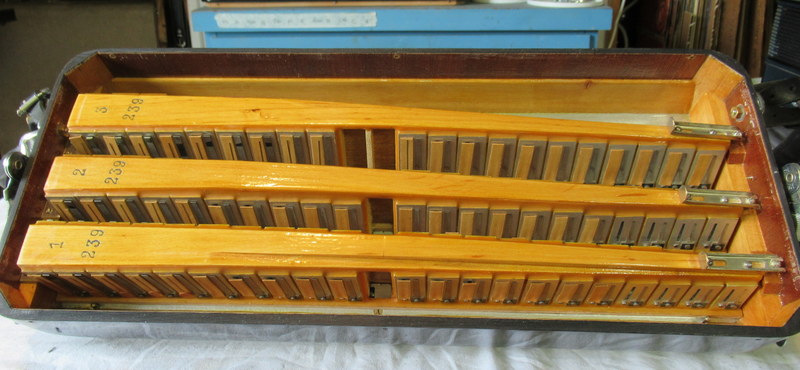
You can take a look with the reed blocks staying in place, but you can also easily remove one to take a closer look. In our picture (above) you may need to loosen or remove just one (or maybe a couple) of screws on the left-side, holding down one of the reed blocks - the right side is held in place with a wooden foot, so after you remove the screw, you can lift it right out at that end. Just remove one reed block!
Here's how a more expensive accordion might look in side - in this case, one of the reed blocks is at right-angles to the others, referred to as a 'tone chamber' or 'cassotto':
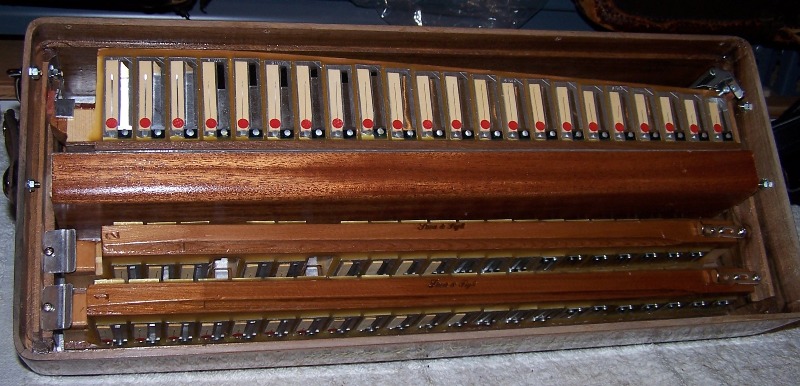
Here's a real accordion:
A typical used accordion won't be in as pristine shape as what's in the above images.
If the accordion has been stored in dry conditions some of the leathers may have dried up, curling or cracking so they don't close tightly. Moreover, the reed piece - steel reed and leather (there are four of these in the picture) - is held in place on the wooden reed block with special beeswax. If this dries out, reeds can get loose and fall right out. (That could be why some of the keys weren't making any sound on one bellows direction).
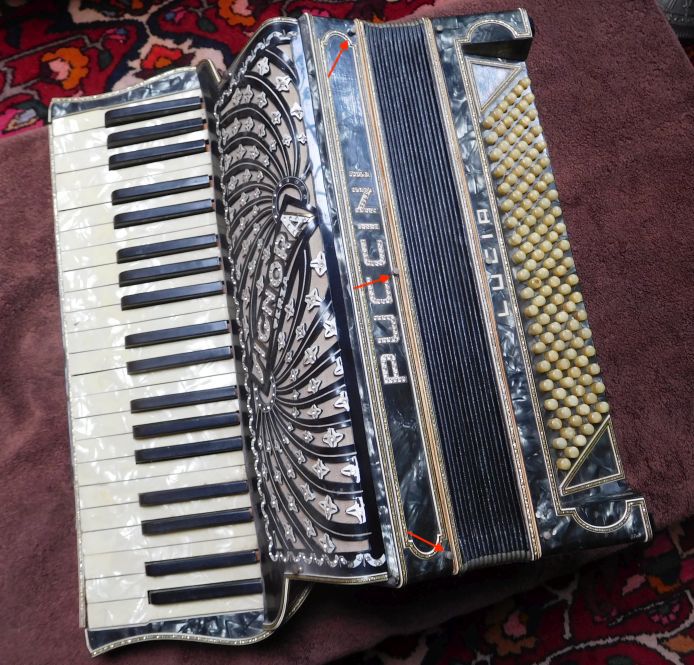 Here's
a real accordion - a pre-World War II Puccini - not a high end brand
name from its era, but I love the appearance of this style of case. A
quick try at playing it suggests it has issues - the bellows flop open
and closed, a clear case of leaky bellows. Even though its lacking
straps, you can try to play it, but because of the bellows issues,
notes sort of wheeze.
Here's
a real accordion - a pre-World War II Puccini - not a high end brand
name from its era, but I love the appearance of this style of case. A
quick try at playing it suggests it has issues - the bellows flop open
and closed, a clear case of leaky bellows. Even though its lacking
straps, you can try to play it, but because of the bellows issues,
notes sort of wheeze.
I opened it up - as expected, there are 6 pins (red arrows in the photo are pointing to the three on the front). Each pulled out easily with a pair of pliers.
The other three pins were in the same sort of location on the back side of the accordion. When all six were removed, the treble section of the accordion almost popped off the bellows.
Here's a view inside the treble section - you can see three wooden reed blocks, with some of the leather strips curling away from the wooden blocks. Not the worst set of leathers I've seen!
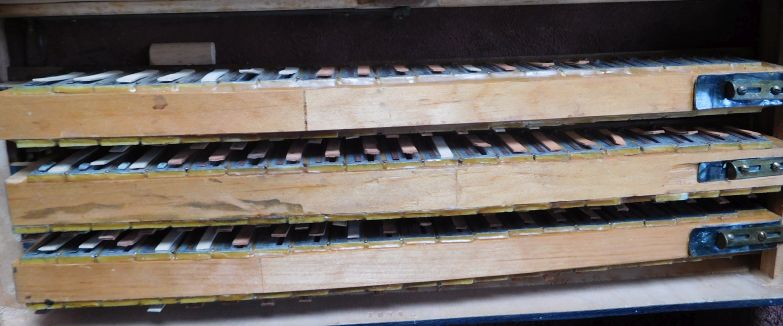
I removed the middle reed block - it was easy to do, unscrewing the single screw on the right, holding it onto the accordion body. Holding it on that end let me life it out - there's a wooden 'foot' on the other end that fits into a slot on that side of the accordion body.

Some of the leathers are lighter coloured and all of these are fitting tightly in place - they were probably updated relatively recently. All the steel reeds seem tightly in place - the wax seems to be in good condition.
Here's a close up of some of the reeds:
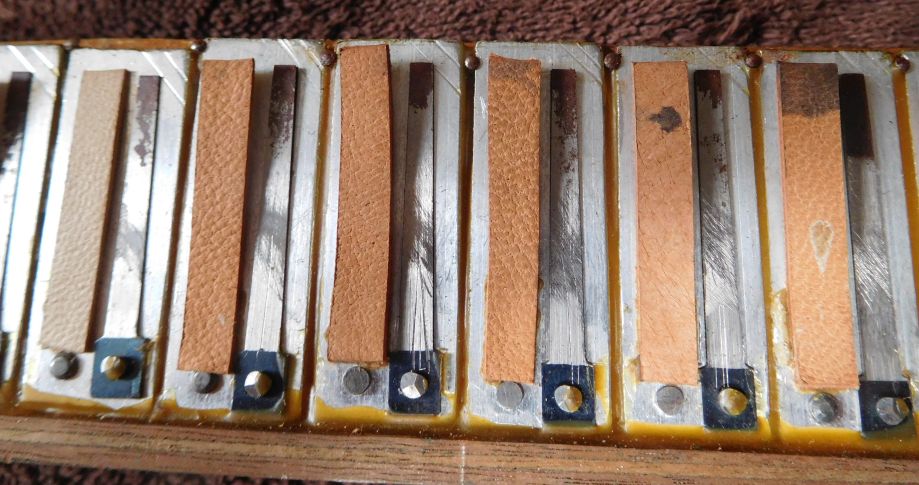
Note the discolouration near the tips of most of those reeds - that's rust. Rust is a combination of iron and oxygen; adding oxygen to iron (or steel) makes it heavier - this alters the tuning of the reed. Each reed can be retuned (a process involving careful scratching near the end or the base of the reed, removing a little of the metal) - but once a reed has become rusty, the rust is liable to spread, meaning it won't stay tuned. As a result, if an accordion has rusty reeds, that's a real problem.
I general suggest staying away from any accordion with rusty reeds. On the Facebook Accordion Repair group, however, Rich Edwards commented: "I have successfully restored an accordion which had rusty reeds- I removed the rust and it has stayed in tune - I think storing it in a dry environment has helped here!"
Despite these problems, I actually bought this Puccini - not with any intention in making it playable. Instead, I have it displayed on a shelf.
It's easy to carefully re-connect the treble section of the accordion onto the bellows - making sure you've got the keys facing the right way! - and reinsert the pins, one at a time. You might have to gently tap on some of the pins with the pliers to get them to go in all the way. After doing this, I put the Puccini back on the shelf.
Older blog postings....
So you think you want to buy an accordion
pt 2: Some quick checks
By Alan Zisman © 2020-03-01; updated 2020-04-10
So you want to get an accordion.
Hopefully you've already looked at Part 1 of this blog and have decided what sort of accordion you want, and now know a little bit about the differences between low-end, mid-range, and high-end accordions.
And you've checked your local online second hand listings site - perhaps Craigslist, perhaps Kijiji, or other.... or perhaps you're in a local pawn shop or music store that has some accordions. Or you're at a garage sale or an estate sale. Or anywhere where you can get your hands on an accordion - whether you've ever played accordion or not.
How can you tell if an accordion's worth buying? Or if you should just walk away?
I'm assuming you're wanting to know if an accordion's playable or if it needs expensive work to make it playable. If you just want something cool and vintage to put on display, that's entirely up to your tastes.
And only you can decide if this playable accordion is the right choice for the musical style(s) you want to play - though Part 1of this blog can help you see what sorts of accordions are commonly used in what sorts of musical styles. And only you can decide whether any given accordion is too heavy or large for you to work with comfortably. (Don't give up to soon - you can learn to work with an accordion that seems to heavy right now. Within limits).
So you've got an accordion in your hands right now. I'm going to assume you haven't played one before - if you have, you can roll your eyes but still do all these tests.
First things first:
-- the keys go on the right side. (You laugh - but I know two people who started out playing with the keys on the left, and not knowing that it felt awkward for a reason).
-- before you try to open or close the bellows: make sure you're holding down a key or button. You need air to get into the accordion when the bellows move - and that happens either when you hold down a key or button (in which case you'll hear a musical sound) or hold down the air release valve on the left hand side (in which case you'll hear a bit of a sucking sound).
-- in order to make any musical sounds, you need to have the bellows in motion, either in or out. If you have a diatonic accordion (see Part 1), which plays different notes depending on whether the bellows are moving in or out, you'll have short, jerky bellow motions in order to access the different notes. On piano-accordions or chromatic button accordions (rare in North America, but common in Europe), you want long, smooth bellow motions. Slowly count to 4 before changing bellows direction.
Things you can quickly check:
-- Visually inspect the accordion. Any obviously broken keys or buttons? Are the keys level? (This is a relatively easy fix, but it's a sign the accordion hasn't been well loved). A little bit of wear on the edge of the bellows - where they might have come in contact with a belt buckle, for instance, is not a deal-breaker, but something to be aware of. Straps in good shape? Short side straps to hold the bellows closed? Strap for the left hand to hold the accordion when you're playing? (There's a wheel on the left side to loosen or tighten this).
-- Holding the air release valve or a key or button, slowly open the bellows - pull them open for a slow count of 4, then change direction and slowly close them. There should be a bit of resistance from the bellows as you open or close them. That indicates good çompression. If they sort of flop open or closed with no effort at all, they're probably leaking. Leaky bellows can be repaired - depending on the source of the leaks - taped (use proper bellows tape - not masking tape!), or replace the metal corners or the gaskets where the bellows attach to the body of the accordion can be replaced (don't use silicone seal!). Or the bellows can be replaced (not cheap).
Reader Rich Edwards on the Facebook Accordion Repair group notes: "I have found that bellows leaks often happen at the corners where the diamond shaped leathers have perished".
Give a good sniff when you first take the accordion out of the case and again when you first open and close the bellows. Notice a musty, mildewy smell? This is accordion bad breath and it's not a good sign. It suggests the accordion has been stored in a damp place - perhaps a basement or garage. Not only is the smell unpleasant, but it's a sign the accordion's steel reeds may be getting rusty. If that's the case, it will be impossible to keep in tune and the reeds may snap if you play them loudly. Replacing the reeds is cost prohibitive. Walk away.
-- Moving the bellows slowly in and out, press each key on the keyboard (treble) side. Then press down each button on the bass side. Does each play a note (or chord for many of the buttons)? Do the keys or buttons come back up after they've been depressed or do some stick? Stuck bass buttons are not (generally) a big deal - but they can happen for a variety of reasons, and it's one more thing to have to deal with.
-- Take the time to test each key to see if the sound it makes when it's played (remember to keep the bellows moving!) sounds musical - more or less in tune. Test each key with the bellows moving out and moving in - there are separate reeds making the sound for each bellows direction. If those two notes sound (pretty much) the same, they're probably in tune. ('In tune' is a relative concept with accordion!). Accordions can be tuned, but it's complex - and something you want a technician to do.
You may feel comfortable buying a used accordion with one or two 'sour' notes or sticky keys - these can be avoided and eventually fixed.... but more than that and you have a major (and potentially expensive) project on your hands.
If your accordion has multiple tone switches on the treble (keyboard) side (see Part 1) test each key (bellows in, bellows out) with the low, middle, and high reeds (depending on how many reeds your accordion has (again, there's a detailed discussion in Part 1). That's because there are separate pairs of reeds in each reed block for each key on the keyboard. You need to know whether the accordion is pretty much in tune - or if there are major tuning issues.
-- Repeat with the left hand buttons. Luckily, you don't have to test every single button (full-sized models have 120 buttons). The buttons are in rows running from the top of the accordion (the side nearest your chin) to the bottom (the side nearest your knees) - the first two of these rows play single notes, the others play chords. You can just test all the buttons on the first or second of these rows. Again, for each button, with bellows moving out and movng in. If your accordion has multiple tone switches on the bass (button) side repeat (with bellows in and out) for each different switch to check all the bass reeds.
Your checklist so far:
____ Visual inspection. Everything look good?
____ Bellows movement: Good compression? No bad smells?
____ Key and button movement: Everything makes a sound? Nothing sticking?
____ Keys all sound in tune (more or less)?
____ Buttons all sound in tune (more or less)?
If the used accordion has passed all these tests, it may be worth buying. To be absolutely sure, you may want to open it up and take a look around. This is easier to do than you probably think - but you'll need a pair of pliers, a screwdriver (usually a flat-head, sometimes a Phillips) and a bit more time (though probably only 5-10 minutes). If it's not your accordion, be sure to ask permission first!
Opening up the accordion:
While there are literally thousands of pieces in an accordion, each accordion is made of three major sections - one houses all the keyboard (treble) side parts, one houses all the bass (button) side parts, and the bellows fits in between these two. The bellows are typically held onto each of the two other sections by six pins.
Put the accordion down on a table (I put a towel down so the accordion won't scratch the table). Open the straps on the sides that hold the bellows closed. With your pliers, carefully pull up on one of the pins holding the treble (keyboard side) onto the bellows, to pull it straight out. Put it aside. Repeat for the other two pins holding the treble side onto the bellows. Pay attention to which pin came from which hole - they'll be easier to put back in if they go back in the same holes each came from.
Turn the accordion over and repeat with the three pins holding the treble side into the bellows - you can leave the bass section attached to the bellows.
When all six pins are removed, you should be able to carefully remove the whole treble section from the bellows. Here's a Youtube clip of this operation:
See - that wasn't so hard!
Take a look inside the treble section. You'll see several wooden reed blocks - 2, 3, or 4 - usually in parallel rows. (The accordion in the video is an expensive model, with two of the reed blocks in a 'tone chamber' at 90-degrees to the other two reed blocks.... you'll probably see something more like this set of three reed blocks:

You can take a look with the reed blocks staying in place, but you can also easily remove one to take a closer look. In our picture (above) you may need to loosen or remove just one (or maybe a couple) of screws on the left-side, holding down one of the reed blocks - the right side is held in place with a wooden foot, so after you remove the screw, you can lift it right out at that end. Just remove one reed block!
Here's how a more expensive accordion might look in side - in this case, one of the reed blocks is at right-angles to the others, referred to as a 'tone chamber' or 'cassotto':

Here's a real accordion:
A typical used accordion won't be in as pristine shape as what's in the above images.
If the accordion has been stored in dry conditions some of the leathers may have dried up, curling or cracking so they don't close tightly. Moreover, the reed piece - steel reed and leather (there are four of these in the picture) - is held in place on the wooden reed block with special beeswax. If this dries out, reeds can get loose and fall right out. (That could be why some of the keys weren't making any sound on one bellows direction).
 Here's
a real accordion - a pre-World War II Puccini - not a high end brand
name from its era, but I love the appearance of this style of case. A
quick try at playing it suggests it has issues - the bellows flop open
and closed, a clear case of leaky bellows. Even though its lacking
straps, you can try to play it, but because of the bellows issues,
notes sort of wheeze.
Here's
a real accordion - a pre-World War II Puccini - not a high end brand
name from its era, but I love the appearance of this style of case. A
quick try at playing it suggests it has issues - the bellows flop open
and closed, a clear case of leaky bellows. Even though its lacking
straps, you can try to play it, but because of the bellows issues,
notes sort of wheeze.I opened it up - as expected, there are 6 pins (red arrows in the photo are pointing to the three on the front). Each pulled out easily with a pair of pliers.
The other three pins were in the same sort of location on the back side of the accordion. When all six were removed, the treble section of the accordion almost popped off the bellows.
Here's a view inside the treble section - you can see three wooden reed blocks, with some of the leather strips curling away from the wooden blocks. Not the worst set of leathers I've seen!

I removed the middle reed block - it was easy to do, unscrewing the single screw on the right, holding it onto the accordion body. Holding it on that end let me life it out - there's a wooden 'foot' on the other end that fits into a slot on that side of the accordion body.

Some of the leathers are lighter coloured and all of these are fitting tightly in place - they were probably updated relatively recently. All the steel reeds seem tightly in place - the wax seems to be in good condition.
Here's a close up of some of the reeds:

Note the discolouration near the tips of most of those reeds - that's rust. Rust is a combination of iron and oxygen; adding oxygen to iron (or steel) makes it heavier - this alters the tuning of the reed. Each reed can be retuned (a process involving careful scratching near the end or the base of the reed, removing a little of the metal) - but once a reed has become rusty, the rust is liable to spread, meaning it won't stay tuned. As a result, if an accordion has rusty reeds, that's a real problem.
I general suggest staying away from any accordion with rusty reeds. On the Facebook Accordion Repair group, however, Rich Edwards commented: "I have successfully restored an accordion which had rusty reeds- I removed the rust and it has stayed in tune - I think storing it in a dry environment has helped here!"
Despite these problems, I actually bought this Puccini - not with any intention in making it playable. Instead, I have it displayed on a shelf.
It's easy to carefully re-connect the treble section of the accordion onto the bellows - making sure you've got the keys facing the right way! - and reinsert the pins, one at a time. You might have to gently tap on some of the pins with the pliers to get them to go in all the way. After doing this, I put the Puccini back on the shelf.
| Video - Looking to buy a used accordion has an interview with Victoria BC's Tempo Trend Music's Martin Hergt that demos how to check the condition of an accordion. Worth watching (15 minutes) |
Older blog postings....
| About
This Blog... I've been writing about computers, software, Internet and the rest of technology since 1992, including a 17 year (1995-2012) stint as 'High Tech Office' columnist for Business in Vancouver. This blog includes thoughts on technology, society, and anything else that might interest me. Comments, emailed to alan@zisman.ca are welcome - and may be published in whole or part. You can follow me on Facebook for notice of new blog postings. |
 |